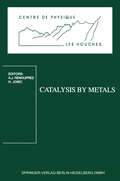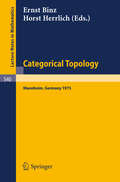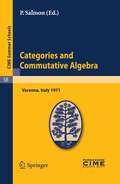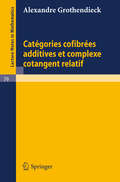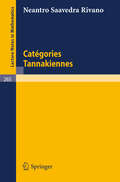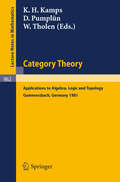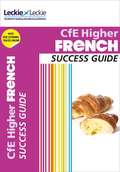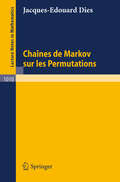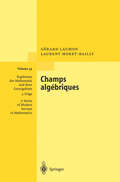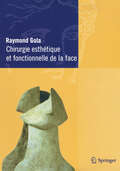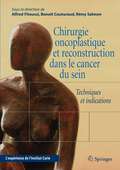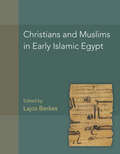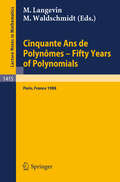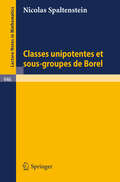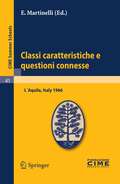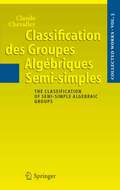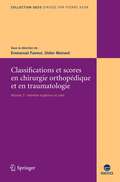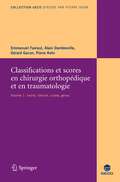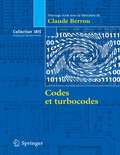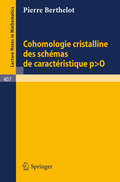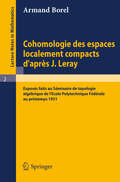- Table View
- List View
Catalysis by Metals: Les Houches School, March 19–29, 1996 (Centre de Physique des Houches #6)
by Albert Jean Renouprez Herve Jobic JobicCatalytic reactions on metals are still nowadays involved in more than half of the chemical industrial processes. The winter school held at "I 'Ecole de in March 1996, 13 years after the first one, accounts Physique des Houches" for an evolution of the field in several directions. First, the emulation between theoretical chemistry and solid state physics has emerged on heuristic concepts, leading not only to explanations of the observed phenomena but, for the first time, to predictions of the reactivity of catalytic systems and of the reaction pathways. The second domain which during these years has become of primary importance is the abatement of the pollution. It concerns not only the conversion of polluting effluents but more and more major modifications of the processes to avoid the production of undesired products. Two striking examples are the necessary catalytic conversion of the 100 000 cubic meter of hydrogen that would be produced in a major incident of a nuclear power plant and the replacement of the CFC. The valorization of agricultural supplies can already be considered as one of the major achievement of catalysis. Indeed, the carbon of biosustainable raw materials represents more than 2 orders of magnitude the amount extracted from fossil fuels each year. Moreover, the molecules are already highly functionalised in contrast with hydrocarbons which require costly steps to be converted to the same products. They are now of current use in the elaboration of cosmetics, vitamins, polymers, etc.
Categorical Topology: Proceedings of the Conference held at Mannheim, 21-25 July 1975 (Lecture Notes in Mathematics #540)
by E. Binz H. HerrlichCategories and Commutative Algebra: Lectures given at a Summer School of the Centro Internazionale Matematico Estivo (C.I.M.E.) held in Varenna (Como), Italy, September 12-21,1971 (C.I.M.E. Summer Schools #58)
by P. SalmonL. Badescu: Sur certaines singularités des variétés algébriques.- D.A. Buchsbaum: Homological and commutative algebra.- S. Greco: Anelli Henseliani.- C. Lair: Morphismes et structures algébriques.- B.A. Mitchell: Introduction to category theory and homological algebra.- R. Rivet: Anneaux de séries formelles et anneaux henseliens.- P. Salmon: Applicazioni della K-teoria all’algebra commutativa.- M. Tierney: Axiomatic sheaf theory: some constructions and applications.- C.B. Winters: An elementary lecture on algebraic spaces.
Categories Confibrees Additives et Complexe Cotangent Relatif (Lecture Notes in Mathematics #79)
by Alexandre GrothendieckCategory Theory: Applications to Algebra, Logic and Topology. Proceedings of the International Conference Held at Gummersbach, July 6-10, 1981 (Lecture Notes in Mathematics #962)
by K. H. Kamps D. Pumplün W. TholenCfE Higher French: Success Guide (PDF)
by Robert Kirk Leckie Leckie Staff Collins Uk StaffExam Board: SQA Level: Higher Subject: French First Teaching: 2014, First Exam: 2015 Prepare to excel in your CfE Higher SQA exam with this Success Guide – the first choice for Scottish students! Prepare to excel in your CfE Higher French SQA examination with this Success Guide – the first choice for successful Scottish students! Success Guides really work because: • Topics in user-friendly sections help you plan your revision in bite-sized chunks • Quick Tests provide the practice that experts say is essential for effective recall • Top tips throughout ensure you know what the examiner will be looking for • Detailed guidance on the exam and Assignment will ensure that you know exactly what you need to do in the assessments • Examples throughout explain new ideas clearly
CfE Higher French: Success Guide (PDF)
by Robert Kirk Leckie Leckie Staff Collins Uk StaffExam Board: SQA Level: Higher Subject: French First Teaching: 2014, First Exam: 2015 Prepare to excel in your CfE Higher SQA exam with this Success Guide – the first choice for Scottish students! Prepare to excel in your CfE Higher French SQA examination with this Success Guide – the first choice for successful Scottish students! Success Guides really work because: • Topics in user-friendly sections help you plan your revision in bite-sized chunks • Quick Tests provide the practice that experts say is essential for effective recall • Top tips throughout ensure you know what the examiner will be looking for • Detailed guidance on the exam and Assignment will ensure that you know exactly what you need to do in the assessments • Examples throughout explain new ideas clearly
Champs algébriques (Ergebnisse der Mathematik und ihrer Grenzgebiete. 3. Folge / A Series of Modern Surveys in Mathematics #39)
by Gérard Laumon L. Moret-BaillyThe theory of algebraic stacks emerged in the late sixties and early seventies in the works of P. Deligne, D. Mumford, and M. Artin. The language of algebraic stacks has been used repeatedly since then, mostly in connection with moduli problems: the increasing demand for an accurate description of moduli "spaces" came from various areas of mathematics and mathematical physics. Unfortunately the basic results on algebraic stacks were scattered in the literature and sometimes stated without proofs. The aim of this book is to fill this reference gap by providing mathematicians with the first systematic account of the general theory of (quasiseparated) algebraic stacks over an arbitrary base scheme. It covers the basic definitions and constructions, techniques for extending scheme-theoretic notions to stacks, Artin's representability theorems, but also new topics such as the "lisse-étale" topology.
Chirurgie esthétique et fonctionnelle de la face
by Raymond GolaCet ouvrage centré sur la chirurgie esthétique faciale repose sur une profonde connaissance de l'anatomie, de la physiologie et de l'étiopathogénie du vieillissement de la face. Les solutions thérapeutiques à visée esthétique sont développées mais en préservant toujours la fonction - gage d'un meilleur résultat immédiat et à plus long terme. Après un rappel du vieillissement cutané et de l'intérêt de l'utilisation de la toxine botulique, les aspects de la chirurgie esthétique de la face sont abordés à travers quatorze chapitres: du lifting frontal à l'otoplastie fonctionnelle en passant par les blépharoplasties, les paupières involutives, l'ophtalmopathie dysthyroïdienne, les faces étroites, la rhinoplastie et la mentoplastie, chaque région est étudiée séparément selon un plan rigoureusement identique: rappel anatomique, étiopathogénie du vieillissement puis technique chirurgicale. Tous les chirurgiens qui s'intéressent à la chirurgie esthétique de la face ne doivent jamais oublier que la chirurgie se doit, avant tout, d'être fonctionnelle.
Chirurgie oncoplastique et reconstruction dans le cancer du sein: Techniques et indications. L’expérience de l’Institut Curie
by A. Fitoussi B. Couturaud R. SalmonLa prise en charge chirurgicale des cancers du sein évolue. L’augmentation du nombre de ces cancers, le dépistage précoce, la généralisation de la multidisciplinarité et l’information des patientes font partie des causes principales de cette évolution. Les patientes porteuses d’un "petit cancer" sont en majorité traitées par un traitement conservateur. Le siège du cancer et le rapport taille du cancer/taille du sein sont cependant générateurs de résultats esthétiques post opératoires parfois médiocres, résultats qui seront aggravés et fixés par l’irradiation post opératoire. Il importe donc d’anticiper la qualité des résultats et de proposer aux patientes des interventions qui vont prévenir les défects esthétiques, tout en assurant un contrôle cancérologique correct. C’est l’application des techniques de chirurgie plastique aux situations cancérologiques qui s’appelle la chirurgie "oncoplastique". L’équipe de l’Institut Curie fait le point sur ces techniques et indications appliquées en 2007 en France.
Christians and Muslims in Early Islamic Egypt (American Studies in Papyrology #56)
by Lajos BerkesThis volume collects studies exploring the relationship of Christians and Muslims in everyday life in Early Islamic Egypt (642–10th c.) focusing mainly, but not exclusively on administrative and social history. The contributions concentrate on the papyrological documentation preserved in Greek, Coptic, and Arabic. By doing so, this book transcends traditional disciplinary boundaries and offers results based on a holistic view of the documentary material. The articles of this volume discuss various aspects of change and continuity from Byzantine to Islamic Egypt and offer also the (re)edition of 23 papyrus documents in Greek, Coptic, and Arabic. The authors provide a showcase of recent papyrological research on this under-studied, but dynamically evolving field. After an introduction by the editor of the volume that outlines the most important trends and developments of the period, the first two essays shed light on Egypt as part of the Caliphate. The following six articles, the bulk of the volume, deal with the interaction and involvement of the Egyptian population with the new Muslim administrative apparatus. The last three studies of the volume focus on naming practices and language change.
Cinquante Ans de Polynomes - Fifty Years of Polynomials: Proceedings of a Conference held in honour of Alain Durand at the Institut Henri Poincare. Paris, France, May 26-27, 1988 (Lecture Notes in Mathematics #1415)
by Michel Langevin Michel WaldschmidtBefore his untimely death in 1986, Alain Durand had undertaken a systematic and in-depth study of the arithmetic perspectives of polynomials. Four unpublished articles of his, formed the centerpiece of attention at a colloquium in Paris in 1988 and are reproduced in this volume together with 11 other papers on closely related topics. A detailed introduction by M. Langevin sets the scene and places these articles in a unified perspective.
Classi caratteristiche e questioni connesse: Lectures given at a Summer School of the Centro Internazionale Matematico Estivo (C.I.M.E.) held in L'Aquila, Italy, September 2-10, 1966 (C.I.M.E. Summer Schools #41)
by E. MartinelliI. Bucur:L’anneau de Chow d’une variété algébrique.- E. Eckmann: Cohomologie et classes caractéristiques.- C. Teleman: Sur le caractère de Chern d’un fibré vectoriel complexe différentiable.- E. Thomas: Characteristic classes and differentiable manifolds.- A. Van de Ven: Chern classes and complex manifolds.
The Classic Short Story, 1870-1925: Theory Of A Genre
by Florence GoyetThe ability to construct a nuanced narrative or complex character in the constrained form of the short story has sometimes been seen as the ultimate test of an author's creativity. Yet during the time when the short story was at its most popular—the late nineteenth and early twentieth centuries—even the greatest writers followed strict generic conventions that were far from subtle. This expanded and updated translation of Florence Goyet's influential La Nouvelle, 1870-1925: Description d'un genre à son apogée (Paris, 1993) is the only study to focus exclusively on this classic period across different continents. Ranging through French, English, Italian, Russian and Japanese writing—particularly the stories of Guy de Maupassant, Henry James, Giovanni Verga, Anton Chekhov and Akutagawa Ryunosuke—Goyet shows that these authors were able to create brilliant and successful short stories using the very simple 'tools of brevity' of that period. In this challenging and far-reaching study, Goyet looks at classic short stories in the context in which they were read at the time: cheap newspapers and higher-end periodicals. She demonstrates that, despite the apparent intention of these stories to question bourgeois ideals, they mostly affirmed the prejudices of their readers. In doing so, her book forces us to re-think our preconceptions about this 'forgotten' genre.
The Classic Short Story, 1870-1925: Theory of a Genre
by Florence GoyetThe ability to construct a nuanced narrative or complex character in the constrained form of the short story has sometimes been seen as the ultimate test of an author's creativity. Yet during the time when the short story was at its most popular - the late nineteenth and early twentieth centuries - even the greatest writers followed strict generic conventions that were far from subtle. This expanded and updated translation of Florence Goyet's influential La Nouvelle, 1870-1925: Description d'un genre à son apogée (Paris, 1993) is the only study to focus exclusively on this classic period across different continents. Ranging through French, English, Italian, Russian and Japanese writing - particularly the stories of Guy de Maupassant, Henry James, Giovanni Verga, Anton Chekhov and Akutagawa Ryūnosuke - Goyet shows that these authors were able to create brilliant and successful short stories using the very simple 'tools of brevity' of that period. In this challenging and far-reaching study, Goyet looks at classic short stories in the context in which they were read at the time: cheap newspapers and higher-end periodicals. She demonstrates that, despite the apparent intention of these stories to question bourgeois ideals, they mostly affirmed the prejudices of their readers. In doing so, her book forces us to re-think our preconceptions about this 'forgotten' genre.
Classification des Groupes Algébriques Semi-simples: The Classification of Semi-simple Algebraic Groups (Collected Works of Claude Chevalley #3)
by Claude ChevalleyThe third volume of the Collected Works of Claude Chevalley assembles his work on semi-simple algebraic groups contained, for the most part, in the notes of the famous "Séminaire Chevalley" held at the Ecole Normale Supérieure in Paris between 1956 and 1958 and written up by participants of the seminar namely, P. Cartier, A. Grothendieck, R. Lazard and J. L. Verdier. These texts have been entirely reset in TeX for this edition, and edited and annotated by Pierre Cartier. Almost 50 years after the original writing, these texts still constitute a choice reference from which to enter and learn this part of the theory of algebraic groups.
Classifications et scores en chirurgie orthopédique et en traumatologie: II. Membre supérieur et pied (Collection GECO)
by Emmanuel Favreul Didier MainardCe livre des classifications en chirurgie orthopédique et en traumatologie se veut un manuel pratique à consulter, chaque fois que l’on veut comparer des résultats, évaluer et comprendre les indications thérapeutiques.Nous n’avons à dessein pas voulu être exhaustifs, ce qui eût été mission impossible, étant donné les nombreux scores et classifications qui se sont développés au fil du temps, tenant compte essentiellement des progrès diagnostiques et thérapeutiques. Chaque fois qu’une nouvelle technique simplifie le traitement, des pans entiers de classifications deviennent obsolètes, mais seulement pour ceux qui ont l’opportunité d’utiliser ces nouvelles méthodes. Un devoir d’historien persiste donc, qui doit permettre à tous de ranger leurs cas en utilisant soit les classifications up to date, soit en restant plus classique.Les scores d’évaluation fonctionnelle ont acquis leur maturité, sont devenus consensuels et, grâce aux groupes de travail des sociétés savantes, sont moins liés à une personnalité ou à une école chirurgicale.L’évaluation a toujours accompagné la pratique chirurgicale. Les chirurgiens doivent connaître ces classifications, non seulement pour rester en règle avec la loi, mais surtout pour rester maîtres de leurs indications.Le premier tome de ces Classifications et scores en chirurgie orthopédique et en traumatologie est consacré aux classifications du rachis, de la hanche et du genou. Le deuxième tome couvre le membre supérieur et le pied.Ces livres se trouveront avec bonheur entre les mains aussi bien des plus chevronnés d’entre nous, mais qui peuvent avoirparfois une hésitation et vouloir vérifier un point particulier, qu’entre celles de nos jeunes collègues, qui sont parfois victimes d’une forme de pensée unique et découvriront ainsi d’autres horizons.
Classifications et scores en chirurgie orthopédique et traumatologique: I. Hanche, Genou, Rachis (Collection GECO)
by Emmanuel Favreul Alain Dambreville Gérard Gacon Pierre KehrCe livre des classifications et des scores en orthopédie et en traumatologie se veut un manuel pratique à consulter. Nous n’avons pas voulu être exhaustifs; ce qui eut été de toute manière impossible vu l'important développement des scores et classifications de ces dernières décennies. Chaque fois qu’une nouvelle technique apparaît et simplifie les traitements, des pans entiers de classifications deviennent obsolètes. Un devoir d’historien persiste donc, qui doit permettre à chacun, selon le cas considéré, d'utiliser, soit des classifications «up to date», soit de rester dans des catégories plus classiques. Ce premier tome est consacré aux classifications du rachis, de la hanche et du genou. Il se trouvera avec bonheur entre les mains aussi bien des plus chevronnés qui peuvent parfois avoir une hésitation et vouloir vérifier un point particulier , qu’entre celles de nos jeunes collègues, qui sont parfois victimes d’une forme de pensée unique et souhaitent découvrir d’autres horizons.
Codes et turbocodes (Collection IRIS)
by Claude Berrou Nicolas PuechCet ouvrage est consacré à l'une des fonctions essentielles des systèmes de télécommunications modernes : le codage de canal ou codage correcteur d'erreurs. À la croisée de la théorie de l'information, des mathématiques et de l'électronique, le codage de canal a connu de nombreux développements depuis les travaux fondateurs de Claude Shannon. Du simple code de Hamming (1950) aux récents turbocodes (1993) en passant par les codes LDPC (1962), le codage de canal a considérablement évolué et a intégré des concepts de plus en plus sophistiqués, en particulier le traitement probabiliste de l'information. Codes algébriques, codes convolutifs et codes concaténés décodés itérativement font la matière principale de l'ouvrage qui comporte également une présentation des modulations numériques, auxquelles le codage de canal est intimement associé pour former le cœur de la couche physique des systèmes de télécommunications. Les aspects théoriques les plus importants sont présentés, la construction des codes est détaillée et justifiée. Les algorithmes de décodage sont développés et, dans la mesure du possible, accompagnés de résultats de simulation, caractéristiques de leur pouvoir de correction et de leurs applications. Les auteurs sont des enseignants-chercheurs reconnus pour leur expertise dans le domaine des algorithmes de codage et de décodage ainsi que des circuits électroniques associés. Codes et Turbocodes a été pensé pour être à la fois un ouvrage de découverte du domaine, une source précieuse d'informations sur les nombreuses techniques imaginées depuis le milieu du vingtième siècle, et une ouverture vers des problèmes non encore complètement résolus.
